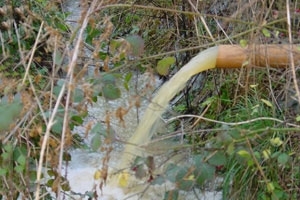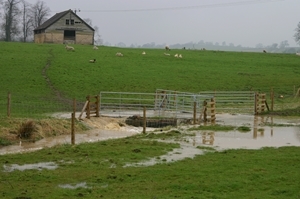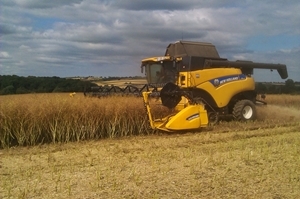Key points
- Propyzamide is a herbicide applied in autumn and winter to control blackgrass in oilseed rape and field beans.
- Herbicides move from treated land to a nearby area of mainly water via overland flow.
- Vegetated buffers are the main method used to reduce pesticide/herbicide concentrations, estimated to halve propyzamide concentrations.
- Increasing the size of buffers from 2m to 20m width around all water courses would be the most effective intervention but requires a large area of land.
- Separating the application of propyzamide across the year is difficult without precise weather forecasting to predict storms, causing the herbicide to be less effective and leading to a higher application the next year.
- Discussions with farmers found that restricting the area of oilseed rape across a catchment was not acceptable as it would require a high level of coordination.
- At the farm scale, alternative crops which help suppress blackgrass (e.g. hybrid barley) would be a viable option, creating a diverse crop rotation and reducing the area of oilseed rape.
- Adopting direct drilling to improve soil stability interested farmers but they identified economic issues when used on clay soils.
Background
 Pesticide contamination of surface water has been an environmental issue for many years. 25 years of research has focused on ways to reduce the high levels of contamination and effectively decrease the transfer to surface water and field runoff. One of these methods is non-inversion tillage. This is where crop residue cover is left on the soil surface after drilling, which reduces the risk of erosion and improves structural stability. Another successful method is vegetated buffer strips. These are areas of land with permanent vegetation that are between the edge of a field and an adjacent area of water, such as a stream or wetland. These buffer strips intercept and slow the runoff of water without interfering with the normal farming operations.
Pesticide contamination of surface water has been an environmental issue for many years. 25 years of research has focused on ways to reduce the high levels of contamination and effectively decrease the transfer to surface water and field runoff. One of these methods is non-inversion tillage. This is where crop residue cover is left on the soil surface after drilling, which reduces the risk of erosion and improves structural stability. Another successful method is vegetated buffer strips. These are areas of land with permanent vegetation that are between the edge of a field and an adjacent area of water, such as a stream or wetland. These buffer strips intercept and slow the runoff of water without interfering with the normal farming operations.
Propyzamide is a type of herbicide used to control blackgrass in oilseed rape and field beans. It is applied in the autumn and winter, and its use increased alongside the rise in oilseed rape farming. Application is recommended when the soil falls below 10°C, and when there is enough soil moisture, but this increases the transfer to the surface water. Although there is no known negative effect of propyzamide on human health or the environment, it is difficult to remove from water for drinking supply. Exceeding the 0.1µg/L limit in water supplies has made the pesticide at risk of being restricted, and this is a concern to farmers who use it regularly.
The aim of this research was to work alongside farmers to design a more effective approach to tackling the use of pesticides and cropping systems and access whether these measures are acceptable to the farmers. Monitoring the water catchments (area of land draining into a watercourse) and use of computer models investigated the efficiency of each method.
What they did
This research is part of the Water Friendly Farming (WFF) project. This project assesses the effectiveness of land management methods to protect freshwater habitats and the ecosystem, while still maintaining profitable farming.
A list of potential strategies that would reduce herbicide concentrations in headwater stream was developed with farmers and the pesticide manufacturer Dow AgroSciences. These strategies included:
- Reducing the area of oilseed rape and use hybrid barley as a competitive crop to limit blackgrass development.
- Exploring different widths of buffer strips along the banks of watercourses.
- Reduce tillage or use non-invasion tillage by not cultivating, to make the soil more stable.
- Mapping the process of increasing soil density (soil compaction) across the fields.
- Sharing soil moisture data in real-time to guide the timing of herbicide application.
- Splitting herbicide applications so the annual limit was not applied at the same time.
These management options were discussed with stakeholders and farmers to evaluate compatibility with the farm business plans, identifying viable options for agricultural best management practices.
Models were created to understand what causes pesticide contamination and the impact the strategies above might have. In these models, simulations were made of stream flow and pesticide concentration in the water by using soil maps, soil properties and weather data. These models accounted for many different factors that affect flow from the soil to the stream including rainfall, evaporation of water, water uptake from plants and how much filters into the soil.
In this study, water samples were collected from the headwater catchments of the WFF project. This area in Leicestershire is managed as conventional arable (used for crops) and pastures (used for grazing). Arable land is drained and has high connectivity to the river system. Water samples were collected every two days during the autumn and winter from 2013 to 2017.
What they found
 Monitoring of the water showed a seasonal presence of propyzamide each winter. The size of the area of oilseed rape had a bigger influence on the quantity present in the water than rainfall or flow volumes.
Monitoring of the water showed a seasonal presence of propyzamide each winter. The size of the area of oilseed rape had a bigger influence on the quantity present in the water than rainfall or flow volumes.
The models used were able to simulate pesticide transfer to the stream and predict the maximum annual concentrations. Overall, the pattern and timing of propyzamide detections were well matched to the predictions and provided a good basis for investigating the different management strategies.
When examining the effectiveness of different management options, the size of the vegetated buffer strip was important. There are a significant number of strips in Stonton catchment, but if these were reduced to 2m, there would be a 50-150% increase in the maximum concentrations of propyzamide in the stream. However, increasing the buffer strips to 20m would reduce the concentrations by 25-70%. Changing from normal tillage methods (e.g. ploughing) to reduced tillage or direct drilling, had a smaller impact on concentration, reducing by 5-16%. If tillage were reduced, there would be increased rainfall filtration to the soil leading to less surface runoff, instead going to the subsurface pathways. Therefore, the impact on pesticides transported to the stream was predicted to be positive, but relatively small.
Delaying application to December showed lower concentrations in the stream across two of the winters. However, the differences in concentration observed was caused by the rainfall pattern, with the maximum concentration occurring 10-20 days after application. Rainfall couldn’t be predicted by the farmers so they couldn’t determine the best application date. Splitting the application across the season would ensure that the total mass of propyzamide in the soil would be smaller, but this would increase the likelihood that one of the applications would be made before rainfall and creating more surface runoff.
These scenarios were discussed in workshops with farmers to see how feasible they were. They thought that local soil moisture data could be a useful means to guide pesticide application, but this would require further investigation. Field drain flow information was less useful as this would come too late to make decisions. The use of buffer strips was considered standard practice and they didn’t see a problem with adopting 6m strips.
However, splitting the application of the herbicide wasn’t viable for farmers. The long gap would mean that at least one application would be applied in sub-optimal conditions, leading to more blackgrass and more herbicide use the following year. Coordinating applications for oilseed rape areas at the catchment scale was ruled out as an option by the farmers because of the logistical limitations on farm business and the need for high level collaboration between them.
At the time of the research, oilseed rape was profitable, with limited economically viable options. However, hybrid barley was used by one farmer who was startled by the beneficial effect this had on supressing blackgrass and making propyzamide use within the rotation more effective.
What does this mean?
 Increasing the width of buffer strips, transferring all land into non-inversion tillage, or modifying the timing of propyzamide application all showed potential to reduce the concentrations of herbicides in the stream. However, the associated reductions were relatively small, with a maximum 25-70% reduction for 20m buffers, and the efficacy varied year on year dependent both on the method used and weather conditions around the time of application.
Increasing the width of buffer strips, transferring all land into non-inversion tillage, or modifying the timing of propyzamide application all showed potential to reduce the concentrations of herbicides in the stream. However, the associated reductions were relatively small, with a maximum 25-70% reduction for 20m buffers, and the efficacy varied year on year dependent both on the method used and weather conditions around the time of application.
Splitting the application of propyzamide over different times was only partially effective because the herbicide would be reduced at any one time. There was also an increased risk of some applications being made soon before a storm, increasing loss to water and reducing the efficiency of the herbicide. In turn, this would increase blackgrass, requiring an increased application of propyzamide the following year.
Modifying the choice of crop to reduce the area of herbicide would be highly effective but this could compromise the farmer’s business and would require a move away from block cropping, the industry norm over the last two decades. Hybrid barley was an exception that could diversify the rotation and reduce the oilseed rape area on individual farms.
Work to define a higher concentration limit, currently 0.1µg/L, that considered downstream dilution at drinking water supply points could identify a compromise, allowing for both water protection and farm business plans.
This work highlights the need to accommodate the objectives of independent farm businesses and the reluctance of farmers to collaborate at the catchment scale to meet regulatory requirements. Development of a shared interest, trust between participants, and economic incentives are needed to stimulate collaboration to reduce contamination of surface water catchments. It is important to consider that rapeseed oil has become less economically worthwhile for farmers since the ban of neonicotinoids in 2013, causing them to abandon the crop. This research is still relevant where rapeseed is grown and for the implications of wider land management.
Read the original paper
Martha L. Villamizar, Chris Stoate, Jeremy Biggs, Carol Morris, John Szczur, Colin D. Brown. Comparison of technical and systems-based approaches to managing pesticide contamination in surface water catchments. Journal of Environmental Management, Volume 260, 2020, 110027.